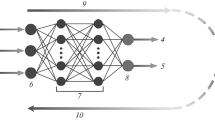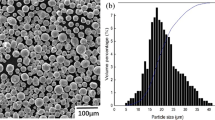Abstract
In this work, the nickel-based powder metallurgy superalloy FGH95 was selected as experimental material, and the experimental parameters in multiple overlap laser shock processing (LSP) treatment were selected based on orthogonal experimental design. The experimental data of residual stress and microhardness were measured in the same depth. The residual stress and microhardness laws were investigated and analyzed. Artificial neural network (ANN) with four layers (4-N-(N-1)-2) was applied to predict the residual stress and microhardness of FGH95 subjected to multiple overlap LSP. The experimental data were divided as training-testing sets in pairs. Laser energy, overlap rate, shocked times and depth were set as inputs, while residual stress and microhardness were set as outputs. The prediction performances with different network configuration of developed ANN models were compared and analyzed. The developed ANN model with network configuration of 4-7-6-2 showed the best predict performance. The predicted values showed a good agreement with the experimental values. In addition, the correlation coefficients among all the parameters and the effect of LSP parameters on materials response were studied. It can be concluded that ANN is a useful method to predict residual stress and microhardness of material subjected to LSP when with limited experimental data.
摘要
本文通过人工神经网络方法实现多次搭接激光冲击作用下材料残余应力与显微硬度的预测。以 镍基粉末冶金高温合金FGH95 为实验材料,基于正交实验设计的思路,确定了多次搭接激光冲击强化 的实验参数。利用X射线应力测量仪和显微硬度计分别测量了实验试件激光冲击强化处理前后的残余 应力和显微硬度分布,并对残余应力和显微硬度变化规律进行了简要分析。构建了4 层网络结构(4-N-(N−1)-2)的人工神经网络预测模型,其中输入为激光能量、光斑搭接率、冲击次数和深度,输出为残 余应力和显微硬度。对不同网络结构的预测性能进行了比较和分析。在最优的模型下(网络结构为4-7-6-2),预测值与实验值十分吻合,预测效果极佳。此外,基于人工神经网络的方法,还研究了激光冲 击强化工艺参数对材料响应的影响。研究表明,在实验数据较为缺乏的情况下,人工神经网络是预测 多次搭接激光冲击作用下材料残余应力和显微硬度的有效方法。
Similar content being viewed by others
References
SEMBIRING J P B A, AMANOV A, PYUN Y S. Artificial neural network-based prediction model of residual stress and hardness of nickel-based alloys for UNSM parameters optimization [J]. Materials Today Communications, 2020, 25: 101391. DOI: https://doi.org/10.1016/j.mtcomm.2020.101391.
SHEN Xiao-jun, SHUKLA P, SUBRAMANIYAN A K, et al. Residual stresses induced by laser shock peening in orthopaedic Ti-6Al-7Nb alloy [J]. Optics & Laser Technology, 2020, 131: 106446. DOI: https://doi.org/10.1016/j.optlastec.2020.106446.
LU Guo-xin, SOKOL D W, ZHANG Yong-kang, et al. Nanosecond pulsed laser-generated stress effect inducing macro-micro-nano structures and surface topography evolution [J]. Applied Materials Today, 2019, 15: 171–184. DOI: https://doi.org/10.1016/j.apmt.2019.01.005.
SADEGHI H, ALITAVOLI M, DARVIZEH A, et al. Dynamic plastic behaviour of strain rate sensitive tubes under axial impact [J]. Thin-Walled Structures, 2019, 143: 106220. DOI: https://doi.org/10.1016/j.tws.2019.106220.
ALIKHANI A, BEYGI R, ZAREZADEH MEHRIZI M, et al. Effect of Mg and Si on intermetallic formation and fracture behavior of pure aluminum-galvanized carbon-steel joints made by weld-brazing [J]. Journal of Central South University, 2021, 28(11): 3626–3638. DOI: https://doi.org/10.1007/s11771-021-4880-x.
ZHU Zhuo, WU Jun-rui, WU Zhi-peng, et al. Femtosecond laser micro/nano fabrication for bioinspired superhydrophobic or underwater superoleophobic surfaces [J]. Journal of Central South University, 2021, 28(12): 3882–3906. DOI: https://doi.org/10.1007/s11771-021-4886-4.
PAEK U C, GAGLIANO F. Thermal analysis of laser drilling processes [J]. IEEE Journal of Quantum Electronics, 1972, 8(2): 112–119. DOI: https://doi.org/10.1109/JQE.1972.1076946.
CHU J P, RIGSBEE J M, BANAŚ G, et al. Laser-shock processing effects on surface microstructure and mechanical properties of low carbon steel [J]. Materials Science and Engineering A, 1999, 260(1–2): 260–268. DOI: https://doi.org/10.1016/S0921-5093(98)00889-2.
ARIF A F M. Numerical prediction of plastic deformation and residual stresses induced by laser shock processing [J]. Journal of Materials Processing Technology, 2003, 136(1–3): 120–138. DOI: https://doi.org/10.1016/S0924-0136(02)01122-6.
NILSSON N J. Artificial intelligence: A modern approach [J]. Artificial Intelligence, 1996, 82(1–2): 369–380. DOI: https://doi.org/10.1016/0004-3702(96)00007-0.
CHEN Lian-wei, YIN Yu-meng, LI Yang, et al. Multifunctional inverse sensing by spatial distribution characterization of scattering photons [J]. Opto-Electronic Advances, 2019, 2(9): 19001901–19001908. DOI: https://doi.org/10.29026/oea.2019.190019.
ARTRITH N, URBAN A. An implementation of artificial neural-network potentials for atomistic materials simulations: Performance for TiO2 [J]. Computational Materials Science, 2016, 114: 135–150. DOI: https://doi.org/10.1016/j.commatsci.2015.11.047.
HUANG Zheng, WU Jia-jun, XIE Feng. Automatic recognition of surface defects for hot-rolled steel strip based on deep attention residual convolutional neural network [J]. Materials Letters, 2021, 293: 129707. DOI: https://doi.org/10.1016/j.matlet.2021.129707.
WANG Yu-heng, LOUIE D C, CAI Jia-yue, et al. Deep learning enhances polarization speckle for in vivo skin cancer detection [J]. Optics & Laser Technology, 2021, 140: 107006. DOI: https://doi.org/10.1016/j.optlastec.2021.107006.
MATHEW J, KSHIRSAGAR R, ZABEEN S, et al. Machine learning-based prediction and optimisation system for laser shock peening [J]. Applied Sciences, 2021, 11(7): 2888. DOI: https://doi.org/10.3390/app11072888.
WU Jia-jun, LI Ying-hao, ZHAO Ji-bin, et al. Prediction of residual stress induced by laser shock processing based on artificial neural networks for FGH4095 superalloy [J]. Materials Letters, 2021, 286: 129269. DOI: https://doi.org/10.1016/j.matlet.2020.129269.
ZHOU Liu-cheng, LI Ying-hong, HE Wei-feng, et al. Deforming TC6 titanium alloys at ultrahigh strain rates during multiple laser shock peening [J]. Materials Science and Engineering A, 2013, 578: 181–186. DOI: https://doi.org/10.1016/j.msea.2013.04.070.
Academic Committee of the Superalloys (CSM). China superalloys handbook [M]. Beijing, China: Standards Press of China, 2012. (in Chinese)
TANG Zhang-han, WANG Ke-dian, GENG Yong-xiang, et al. An investigation of the effect of warm laser shock peening on the surface modifications of [001]-oriented DD6 superalloy [J]. The International Journal of Advanced Manufacturing Technology, 2021, 113(7–8): 1973–1988. DOI: https://doi.org/10.1007/s00170-021-06763-7.
VILD A, TEIXEIRA S, KÜHN K, et al. Orthogonal experimental design of titanium dioxide—Poly(methyl methacrylate) electrospun nanocomposite membranes for photocatalytic applications [J]. Journal of Environmental Chemical Engineering, 2016, 4(3): 3151–3158. DOI: https://doi.org/10.1016/j.jece.2016.06.029.
DHAKAL B, SWAROOP S. Effect of laser shock peening on mechanical and microstructural aspects of 6061-T6 aluminum alloy [J]. Journal of Materials Processing Technology, 2020, 282: 116640. DOI: https://doi.org/10.1016/j.jmatprotec.2020.116640.
SCHALKOFF R-J. Artificial neural networks [M]. New York: McGraw-Hill, 1997.
YIN Yan-jun. Study of flow law, microstructure and mechanical properties of 316L stainless steel by selective laser melting [D]. Beijing: University of Science and Technology Beijing, 2019. (in Chinese)
WU Jia-jun, ZHAO Ji-bin, QIAO Hong-chao, et al. A method to determine the material constitutive model parameters of FGH4095 alloy treated by laser shock processing [J]. Applied Surface Science Advances, 2020, 1: 100029. DOI: https://doi.org/10.1016/j.apsadv.2020.100029.
WANG Cheng-tao, LI Wei, WANG Yu-qiao, et al. Study of electrochemical corrosion on Q235A steel under stray current excitation using combined analysis by electrochemical impedance spectroscopy and artificial neural network [J]. Construction and Building Materials, 2020, 247: 118562. DOI: https://doi.org/10.1016/j.conbuildmat.2020.118562.
GUO Wei, SUN Ru-jian, SONG Bin-wen, et al. Laser shock peening of laser additive manufactured Ti6Al4V titanium alloy [J]. Surface and Coatings Technology, 2018, 349: 503–510. DOI: https://doi.org/10.1016/j.surfcoat.2018.06.020.
GILL A, TELANG A, MANNAVA S R, et al. Comparison of mechanisms of advanced mechanical surface treatments in nickel-based superalloy [J]. Materials Science and Engineering A, 2013, 576: 346–355. DOI: https://doi.org/10.1016/j.msea.2013.04.021.
QIAO Hong-chao, ZHAO Ji-bin, GAO Yu. Experimental investigation of laser peening on TiAl alloy microstructure and properties [J]. Chinese Journal of Aeronautics, 2015, 28(2): 609–616. DOI: https://doi.org/10.1016/j.cja.2015.01.006.
SUNG A H. Ranking importance of input parameters of neural networks [J]. Expert Systems with Applications, 1998, 15(3–4): 405–411. DOI: https://doi.org/10.1016/S0957-4174(98)00041-4.
LU G X, LIU J D, QIAO H C, et al. Microscopic surface topography of a wrought superalloy processed by laser shock peening [J]. Vacuum, 2016, 130: 25–33. DOI: https://doi.org/10.1016/j.vacuum.2016.04.032.
Funding
Projects(51875558, 51471176) supported by the National Natural Science Foundation of China; Project (2017YFB1302802) supported by the National Key R&D Program of China
Author information
Authors and Affiliations
Corresponding authors
Additional information
Contributors
WU Jia-jun developed the overarching research goals and edited the draft of manuscript. HUANG Zheng conducted the literature review and wrote the manuscript. QIAO Hong-chao wrote the manuscript. WEI Bo-xin, ZHAO Yong-jie and LI Jing-feng edited the manuscript. ZHAO Ji-bin validated the proposed method with practical experiments and wrote the first draft of manuscript.
Conflict of interest
WU Jia-jun, HUANG Zheng, QIAO Hong-chao, WEI Bo-xin, ZHAO Yong-jie, LI Jing-feng and ZHAO Ji-bin declare that they have no conflict of interest.
Rights and permissions
About this article
Cite this article
Wu, Jj., Huang, Z., Qiao, Hc. et al. Prediction about residual stress and microhardness of material subjected to multiple overlap laser shock processing using artificial neural network. J. Cent. South Univ. 29, 3346–3360 (2022). https://doi.org/10.1007/s11771-022-5158-7
Received:
Accepted:
Published:
Issue Date:
DOI: https://doi.org/10.1007/s11771-022-5158-7




